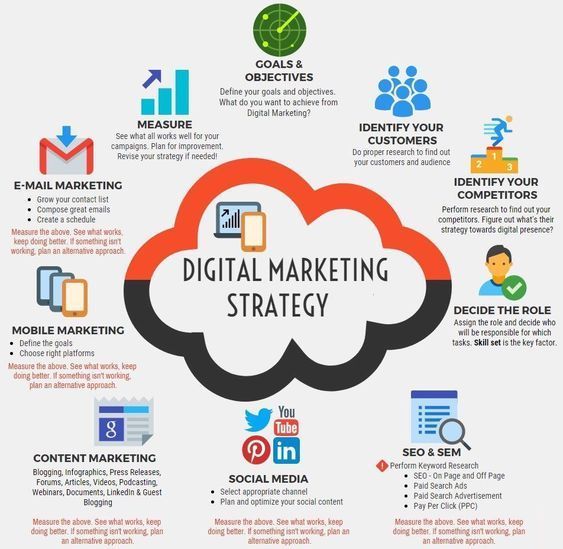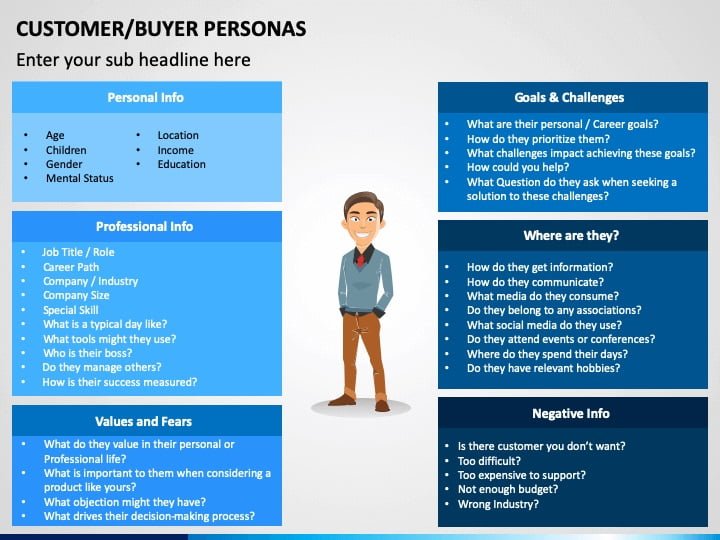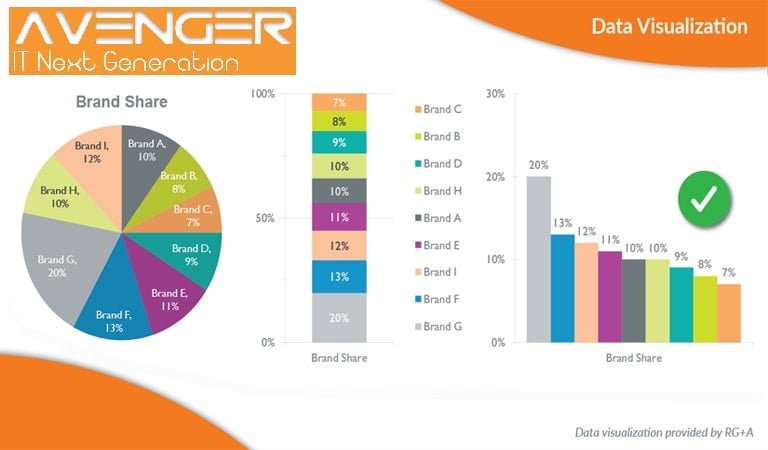Preface: A digital marketing strategy that is very practical
This outlook can multiply your speed as your business expands. Digital marketing is done in many ways today. How do you want to create, adjust and maintain your digital marketing strategy?
What is a Digital Marketing Strategy?
In a nutshell: Digital Marketing Strategy is a set of steps that will help you achieve your goals. The term “strategy” sounds scary, but the impact of the right digital strategy is amazing for business.
Simply put, the strategy of an action plan is to achieve one or more desirable goals. For example, your primary goal may be to increase your audience by 25 percent from last year.
Depending on the scale of your business, your marketing strategy may include several different goals and segments, but having a simple look at the strategy will also help you achieve your goals.
Despite the simplification of the strategy, you can undoubtedly achieve a difficult structure. First, we want to see what a digital marketing campaign is And then let’s look at 7 marketing strategies that are most effective for your digital marketing strategy.
What is a Digital Marketing Campaign?
Note that digital marketing strategy should not be the same as digital marketing campaigns, but how can we distinguish between them?
As mentioned before, digital strategy is a set of actions that will help you achieve your marketing goals. Digital marketing campaigns are like building blocks or a set of actions in your strategy that drive you to your goal.
For example, you might decide to launch a campaign to share some of your important content on Twitter to reach more audiences through this channel. This campaign is part of your strategy to generate more audiences.
Keep in mind that if a campaign lasts several years, it is not a strategy, but a tactic along with other campaigns to create your strategy.
You are now familiar with the basics of digital strategy and digital marketing campaigns.
How to create a comprehensive digital strategy?
1. Create your customer shed
For any marketing strategy (offline or online) you need to know who you are marketing to. The best digital marketing strategy is to build on the personality or personality of the customer and is the first step in building a customer personalization strategy.
The buyer persona shows your ideal customers. You can achieve this by researching, polling and interviewing your target audience. It is very important to get this information factually.
To create a picture of your persona, do some research on a combination of customers, prospects, and people who are out of your contact list and aligned with your target audience.
But what kind of information do you need to collect from your customers’ personalities and pass them on to someone who is implementing your digital marketing strategy?
Quantitative (demographic)
Location
Using web analytics tools like Google Analytics you can find out where your website traffic is coming from.
Age
Depending on your business, the age of your audience may or may not be relevant. It is best to collect this data and identify trends in customer databases.
Income
It is best to ask for sensitive information, such as personal income, in a face-to-face interview, and some may be reluctant to share such information through the form.
job title
A job title can give you a general idea of your customers and is mostly about B2B marketing companies.
Qualitative information (psychology)
Targets
You may already have a good idea of your goals, depending on the need for your services or products. However, it is best to speak with your customers, internal sales experts, and customer service representatives to confirm your assumptions.
Challenges
Contact customers, salespeople, and customer service representatives again to find common problems with your audience.
Hobbies and interests
Talk to customers and people who are in touch with your target audience. For example, if you are a fashion brand you need to know if your audience is interested in fitness and wellness, so you can implement your future content.
priorities
Learn more about your business with your target customers and audiences. For example, if you are a B2B software company, it can be valuable to know that your audience is likely to value customer support above the competitive prices.
Get this information and create one or more staff, like Muller Marketing (pictured below), and make sure they are at the core of digital marketing strategy.
2. Identify the goals and digital marketing tools you need
Your marketing goals should be aligned with your business goals. For example, if your business goal is to increase your revenue by 20% or your goal as a marketer might be to increase your lead or audience by 50% through the website to make your company more successful.
Whatever your goal is, you need to know how to measure it, rather than being able to measure it (for example, having the right digital marketing tool). How do you measure the effectiveness of your digital marketing strategy? The answer to this question varies for everyone, depending on your purpose, but it is essential to make sure your work is right. Because these metrics will help you shape your future strategies. You can use the Reporting plugin in the HubSpot to get all the marketing and sales information you need.
3. Evaluate your digital marketing channels.
When considering digital marketing channels and your assets to incorporate into your strategy, it is best to consider the bigger picture first as this will prevent you from drowning. You can segment your digital assets and assets using the “Media you own”, “Media you earned” and “Media you paid for” frameworks. Your media includes all media owned by your brand or company, including your website, social networking profiles, content or blog images. Your media are those that your business has complete control over. It can also include some content outside of your website, such as a blog that you publish in the Medium.
Earned or Acquired Media (Earned Media)
Earned media refers to the word of mouth marketing that promotes your people across different channels without paying you. Like your content on other websites, PR or PR work, or feedback you get from a customer experience. You can get a media outlet by naming your name in a magazine or by publishing your content to customers or getting a positive outlook.
Paid media or Paid media
The media we have to pay for advertising. Companies or organizations pay media to attract customers to their business. These include content such as Google AdSense, social media advertising, peer-to-peer advertising or nitro (such as sponsored posts on other websites) and any other media where a brand needs to be paid for.
Classify a list of these media into one excel so that you have a clear picture of the media available, the media acquired, and the media you have to pay for.
Digital Marketing Strategy You may have a mix of different channels and help achieve your goals if they all work together. For example, it might be a piece of your content on a landing page of a website. To grow your audience through content, you have to do your best to create engaging content so that it can be shared with other people on social networks. Doing so will increase traffic.
Put it on your Facebook page to succeed, but pay more for it to be seen.
It’s just like having 3 people work together to reach their goal. Of course, it is not mandatory to use three people. If you are successful in the media you own and the earned or earned media, you may no longer need to invest in paid media. Evaluate the best solution to reach your goals, and then add the channels that are right for your business.
You already know what you are using, you can start now and decide what to keep and delete.
4. Investigate and plan for media that you own
At the heart of digital marketing is the media that belongs to you and almost always forms the content. Any message your brand publishes can be publicly categorized as content. Such as a page from your site, product descriptions, blog posts, e-books, infographic information, or social networking posts. So it can be said that producing unique and quality content helps you turn your site visitors into leads and customers and helps improve your branding. You can also upgrade your rank in search engines.
To build your digital marketing strategy, decide what content will help you reach your goals. If your goal is to have a 50% increase in the number of people coming to you through the website, it’s unlikely you want a page about us to be included in your strategy.
If you have prepared an e-book and placed it on your website and received customer information through a form then submit your book you will probably get more audiences. The following is a summary of the process by which content can be used to achieve your digital marketing goals.
Check your existing content.
List your existing content and rate each one based on what works best for your goals. For example, if your goal is to generate leads, rank the content that has the most leads for your site.
There may be a specific blog post, an e-book or even a specific page on your website that has attracted more leads.
The idea here is to work out what is working right now and plan accordingly.
Identify chats in your existing content
Based on the buyer persona, you can identify any chat in the content.
If you have a mathematics teaching school and have done research on your audience persona, you have found that your biggest challenge is finding a way to create a passion for reading. But you also don’t have any content on it, so you start producing interesting content.
Or perhaps by examining the content available, you may find that e-books can have a huge impact on your audience and turn a large audience into customers (even more than hosting a webinar). Better Than About Your Math School Case You might eventually decide to add an e-book on “How to study more passionately?” do. This can lead to an audience that has such a challenge.
Create a content plan
Based on your findings and the chats you’ve identified, create a content plan that contains the content you need to reach your goals. This plan should include:
- Title
- format
- Target
- Advertising channels
- Why you create such content
- Priority level (to help you decide what gives you the most excitement)
5. Investigating and planning for acquired or earned media
Evaluating your previously acquired media can help you focus on which media. Look at where your traffic and audience are coming from. This way you can rank your acquired media.
You can get information from tools like Google Analytics.

You may find that a specialized article related to your industry can get a lot of traffic to your website or that LinkedIn is where most people share your content. This, in turn, causes a lot of traffic.
The idea is to be able to create an image of the acquired media and get important data to help you achieve your goals. However, if there is something new you haven’t tried before, be sure to try it.
6. Reviewing and planning paid media media
This process involves many of the same processes: To do this, you need to evaluate your paid media on each platform separately (such as Google Ades, Facebook, Twitter, etc.). You need to know what might help you achieve your current goals.
If you spend a lot of money on AdWords and don’t see the results you expected, it may be time to refine or completely abandon your approach and focus on another platform that looks to deliver better results. Wants to leave.
At the end of the process, you should have a clear idea of the media you want to use or remove from your strategy.
7. Aggregate all items
You do your planning and research and finally, get a holistic view of the elements of your digital marketing strategy. All you have to have in the end is:
- A transparent profile of the audience persona
- One or more specific marketing goals
- A list of available acquired and paid media
- Review existing, acquired and paid media
- Create content creation plans for the present and the future
Now is the time to combine all of these to create a single strategy document. Let’s go back to the definition of a digital marketing strategy: a set of actions that will help you achieve your goals with online marketing.
Conclusion:
Every company with a website will have analytics, but many senior managers don’t ensure that their teams make or have the time to review and act on them. Once a strategy enables you to get the basics right, then you can progress to the continuous improvement of the key aspects like search marketing, site user experience, email, and social media marketing. So that’s our top 10 problems that can be avoided with a well thought-through strategy.
The bottom line with any digital marketing campaign or tactic is to stay aligned with your core purpose, not just your product. Focus on benefits, address customer’s real needs, and understand what makes them tick. As well, stay on top of which social trends are affecting various demographics. Remember that it’s your job to “follow” the customer and not the other way around.
ABOUT US
Working with Digital marketing, SEO services, and website design and Migrating services to PWA with a highly experienced team for years, َAvenger IT Next Generation has been able to meet the needs of people in various businesses and help businesses grow. Continuously updating their level of knowledge and exploring different markets has surpassed the pioneers in this field and incorporate successful experiences into their careers.
Avenger IT Next Generation is a website design and development agency and an SEO agency to promote your business, call with us.






